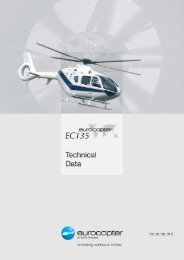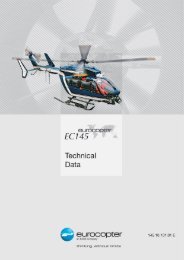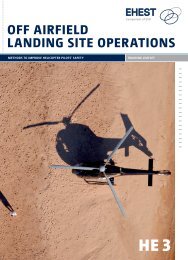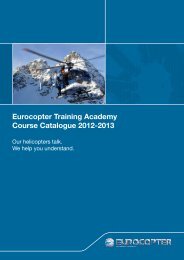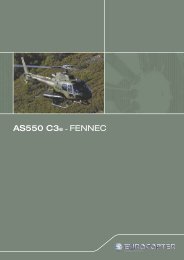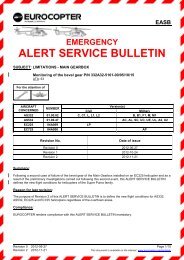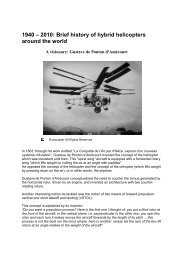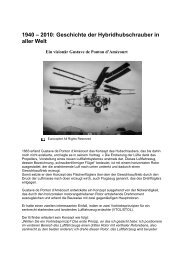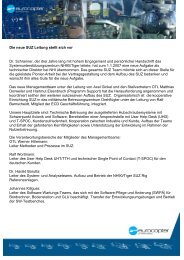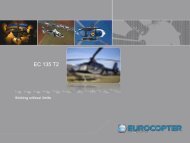Document - Helicopter Airmanship - Irish Aviation Authority
Document - Helicopter Airmanship - Irish Aviation Authority
Document - Helicopter Airmanship - Irish Aviation Authority
You also want an ePaper? Increase the reach of your titles
YUMPU automatically turns print PDFs into web optimized ePapers that Google loves.
<strong>Helicopter</strong><br />
airmansHip<br />
mEtHodS to improvE HElicoptEr pilotS SafEty<br />
training lEaflEt<br />
HE 2
2 >> <strong>Helicopter</strong> airmanship
content<br />
Training leaflet >> 3<br />
Introduction 5<br />
1.0 Knowledge 7<br />
1.1 Learning from the mistakes of others<br />
1.2 Recurrent Training<br />
1.3 Personal Limitations<br />
2.0 Pre-flight preparations 9<br />
2.1 Paperwork<br />
2.2 Weather<br />
2.3 VFR Navigation<br />
2.4 Radio<br />
2.5 Weight and Balance<br />
2.6 Performance<br />
2.7 Fuel Planning<br />
2.8 Destination<br />
3.0 Flying practice 13<br />
3.1 Pre-Flight<br />
3.2 Fuelling<br />
3.3 Passengers and Baggage<br />
3.4 Take-off<br />
3.5 En-route<br />
3.6 Airspace<br />
3.7 Radio/Transponder<br />
3.8 En-route Diversion<br />
3.9 Degraded Visual Environment (DVE)<br />
3.10 Lost<br />
3.11 Control Considerations<br />
3.12 Environmental<br />
3.13 Wake Turbulence and Rotor Wash<br />
3.14 Circuit Procedures<br />
3.15 Landing<br />
4.0 Special Considerations 19<br />
5.0 Summary 21<br />
6.0 <strong>Helicopter</strong> Ground Operations Signals 22
4 >> <strong>Helicopter</strong> airmanship<br />
Final report<br />
eHest analysis oF 2000 – 2005<br />
For a download simply scan<br />
the QR-Code or visit<br />
http://easa.europa.eu/essi/<br />
ehest/wp-content/uploads/2010/<br />
10/EHEST-Brochure.pdf
Introduction<br />
<strong>Airmanship</strong> is defined by EASA Part FCL as:<br />
the consistent use of good judgement and well-developed knowledge, skills and<br />
attitudes to accomplish flight objectives.<br />
Training leaflet >> 5<br />
The EHEST review of helicopter accidents 2000 to 2005 1 revealed 140 general aviation<br />
helicopter accidents in Europe identifying the following (causal and contributing) factors:<br />
• Pilot decision making and risk assessment<br />
• Mission Planning<br />
• Pilot misjudged own limitations/capabilities, overconfidence<br />
• Pilot inexperienced<br />
• Inadequate consideration of weather/wind<br />
• Failed to follow procedures<br />
• Pilot control/ handling deficiencies<br />
• Failed to recognise cues to terminate current course of action or manoeuvre<br />
• Inadvertent entry into IMC, vision restricted by meteorological conditions<br />
• Wilful disregard for rules and SOPs<br />
The majority of these factors are related to airmanship.<br />
Comprehensive knowledge, careful pre-flight preparations, frequent flying practice and<br />
avoidance of complacency are the best insurance against becoming an accident statistic.<br />
1 <strong>Document</strong> ref.: Final Report - EHEST Analysis of 2000 – 2005 European helicopter accidents (ISBN 92-9210-095-7)
6 >> <strong>Helicopter</strong> airmanship<br />
1. KnoWleDGe<br />
1.1 Learning from the mistakes of others<br />
Learn from the mistakes of others and you might live long enough not to make all of<br />
the mistakes yourself! Improve your knowledge by reading authorative aviation safety<br />
materials such as from EHEST, IHST, HAI, Skybrary and FAAST; Air Accident reports from<br />
the Accident Investigation Bureaus and EASA, National <strong>Aviation</strong> <strong>Authority</strong> and<br />
manufacturer safety publications.<br />
1.2 Recurrent Training<br />
Revise your basic knowledge and flying skills by attending a Manufacturer’s Safety<br />
Course or having a regular training flight with an instructor, which may include, but not<br />
necessarily be limited to:<br />
• in single engine helicopters, practice engine failures so that it is a reflex response<br />
to lower the collective IMMEDIATELY and to enter autorotation<br />
• in multi engine helicopters, practice simulated OEI procedures<br />
• sloping ground take-offs and landings<br />
• review the appropriate emergency procedures for the type of helicopter<br />
• AWARENESS of (but not necessarily demonstrated) height/velocity curve,<br />
dynamic roll-over, vortex ring, ground resonance, LTE and engine icing situations.<br />
(See EHEST training leaflet HE1 2 .)<br />
• awareness of the importance of maintaining rotor rpm/energy, and recovery low/<br />
high rotor rpm conditions<br />
• operation from confined areas and off airfield landing sites (see EHEST training<br />
leaflet HE3 3 .)<br />
Study the Rotorcraft Flight Manual (RFM) / Pilot’s Operating Handbook (POM) so that<br />
you are thoroughly familiar with:<br />
• limitations; including rotor speeds/power settings and the HV diagram<br />
• normal, abnormal and emergency procedures, consider your actions should<br />
you encounter abnormal or emergencies in flight<br />
• weight and balance calculations<br />
2 <strong>Document</strong> ref.: EHEST training leaflet HE1, Safety Considerations, Methods to Improve <strong>Helicopter</strong> Pilot’s Capabilities<br />
3 <strong>Document</strong> ref.: EHEST training leaflet HE3, Off Airfield Landing Site Operations
<strong>Helicopter</strong> preFliGHt<br />
planninG cHecKlist<br />
For a download simply scan<br />
the QR-Code or visit<br />
http://easa.europa.eu/essi/ehest/<br />
wp-content/uploads/2010/<br />
10/EHEST-Pre-flight-planning-<br />
Checklist.pdf<br />
Whenever possible, particularly if you have not recently flown, sit in the helicopter and<br />
re-familiarise yourself with the cockpit layout as well as normal/abnormal/emergency<br />
checklist drills.<br />
1.3 Personal Limitations<br />
Training leaflet >> 7<br />
You must know your own level of competence / experience and operational limitations.<br />
A more cautious approach is necessary in the case of experienced fixed wing pilots, who<br />
have little helicopter experience. You may be confident and relaxed in the air but will<br />
not yet have developed the reflex responses, control feel, coordination and sensitivity<br />
necessary in a helicopter. You may well react incorrectly to a low rotor rpm warning. Also<br />
take special care when transitioning to a new type or activity as your past experience<br />
may not be relevant and could lead to over confidence.
8 >> <strong>Helicopter</strong> airmanship<br />
2. pre-FliGHt<br />
preparations<br />
2.1 Paperwork<br />
EASA regulations require that a valid licence and valid medical certificate must be carried<br />
by the pilot when exercising the privileges of the licence; in addition a pilot is also<br />
required to carry personal ID containing a photograph. The exercise of the privileges<br />
granted by the licence is dependent on the validity of the ratings; therefore the pilot must<br />
ensure that the relevant ratings and any recent experience requirements are also in date.<br />
<strong>Helicopter</strong> documentation including Certificate of Airworthiness, ARC, Maintenance<br />
Releases, Certificate of Registration, Aircraft Radio Licence and Insurance must be in date<br />
and carried during flight.<br />
2.2 Weather<br />
Ensure you get an aviation weather forecast from an authorised source, heed what it<br />
says, (decodes are available on the internet) and make a carefully reasoned GO/NO GO<br />
decision. Do not let self induced or passenger pressure influence your judgement.<br />
The necessity to get home (Homeitis) has been a frequent casual course of accidents.<br />
Establish clearly in your mind the en-route conditions, the forecast, and possible<br />
diversions in case of deteriorating weather. Have a planned detour route if you are<br />
likely to fly over high ground which may be cloud covered.<br />
In piston engine helicopters be aware of the conditions that lead to the formation of<br />
engine icing, comply with the Rotorcraft Flight Manual (RFM) / Pilot’s Operating<br />
Handbook (POM) instructions regarding the use of Carb heat or Engine anti-ice and<br />
remember to include Carb Air Temp and OAT in your regular instrument scan.<br />
In wet weather beware of misting of windshield and windows, especially when carrying<br />
passengers with wet clothes and carry a cloth to assist demisting the windshield prior to<br />
take-off.<br />
2.3 VFR Navigation<br />
Use appropriate current aeronautical charts, folded to show the planned track, (as<br />
it may be difficult to re-fold when you are airborne.) Other non aeronautical charts or<br />
maps of a more detailed nature maybe useful particularly when landing off airfield.<br />
Check from an authorised source NOTAMs, AICs, Temporary Navigation Warnings, such<br />
as air displays, frequency changes or Emergency Restricted Airspace.
↑ cHart prEparation<br />
080° / 15 nm<br />
Prepare a thorough route plan with particular reference to transit altitudes, safety<br />
altitudes and suitable diversions. Familiarise yourself with geographical features, way<br />
points, airspace and any helicopter special procedures. GPS may be used as a back-up<br />
for navigation planning not a substitute for it.<br />
In a single engine helicopter avoid flying over congested areas or hostile terrain where a<br />
safe forced landing is not assured. In most countries it is forbidden to fly over High<br />
Security Prisons and Nuclear Facilities. Note high ground, masts and other obstructions<br />
in planning your safe altitudes.<br />
Plan to reach your destination at least one hour before sunset, unless qualified, equipped<br />
and prepared for night flying. Note: Commercial Air Transport night flying is prohibited in<br />
single engine helicopters in most States.<br />
Be aware of and comply with local regulations pertaining to low flying and generally<br />
fly no lower than is necessary to avoid annoyance to persons on the ground and reach<br />
a safe landing site in the event of an emergency.<br />
2.4 Radio<br />
Have all necessary radio frequencies to hand, including those for en-route, destination<br />
and diversion aerodromes, ATIS, VOLMET, NAV AIDS (including Morse decode) etc.<br />
Remember in an emergency 121.5 is available.<br />
Review periodically radio procedures, phraseology etc. (See EGAST radiotelephony guide 4 .)<br />
Carry a mobile phone in case you make a precautionary landing or your destination is<br />
outside radio coverage.<br />
2.5 Weight and Balance<br />
Use the RFM empty weight and centre of gravity (C of G) of the actual helicopter you are<br />
operating. Ensure that the helicopter’s maximum/minimum weights are complied with.<br />
Check that the C of G is within limits for take-off, in-flight, landing and as a worse case<br />
scenario zero fuel. Be aware of and recalculate C of G changes when loading or<br />
off-loading passengers and or baggage, and if you have to carry ballast; make sure it is<br />
suitable and properly secured.<br />
4 <strong>Document</strong> ref.: EGAST A Guide to Phraseology for General <strong>Aviation</strong> Pilots in Europe<br />
120° / 12 nm<br />
Training leaflet >> 9
10 >> <strong>Helicopter</strong> airmanship<br />
never attempt to fly a helicopter which is outside the permitted weight/C of G range<br />
and performance limitations. Not only is it illegal but it is dangerous as you may have<br />
insufficient cyclic authority or power to control the helicopter.<br />
2.6 Performance<br />
Refer to the performance section of the RFM/POM for the relevant information on the<br />
helicopter type you are flying, i.e. Hover In Ground Effect (HIGE), Hover Out of Ground<br />
Effect (HOGE) etc.<br />
Use the recommended take-off and landing profiles. avoid / minimise flight within<br />
the avoid areas of the height-velocity diagram.<br />
2.7 Fuel Planning<br />
Ideally plan to land with no less than a 1⁄4 tank of fuel or the stated VFR/IFR planning<br />
minima for the operation. Do not rely solely on the gauge(s) or low fuel warning light;<br />
wherever possible dip the tanks before takeoff; know the hourly fuel consumption of<br />
your helicopter; in flight, check that the gauge(s) agree with your calculations.<br />
Frequent use of carb heat will increase fuel consumption.<br />
Understand the operation and limitations of the fuel system, gauges, pumps, mixture<br />
control (do not lean mixture unless it is permitted) and unusable fuel.
↑ viEW from HElicoptEr<br />
2.8 Destination<br />
Check for any special procedures due to activities at your destination, such as<br />
parachuting, gliding, micro-lighting etc and the location of the helicopter operating<br />
area. If your destination is a private landing site, the surroundings and information<br />
available may be very different from the licensed aerodrome at which you learnt to fly<br />
(see EHEST training leaflet HE3 5 ).<br />
Try to chose a landing site where you can use the recommended profiles, but if that is<br />
impossible consider:<br />
a check out with an instructor or someone who knows the site well, or<br />
a check from the ground of the potential problems associated with different wind<br />
directions, or the reduced power available on a hot day.<br />
Always minimise the time that the helicopter is at greatest risk from an engine failure.<br />
In a helicopter, you cannot just land anywhere – prior permission may be required<br />
(PPR) from the land owner and also at most aerodromes. Certain States have additional<br />
regulations pertaining to off airfield landings.<br />
5 <strong>Document</strong> ref.: EHEST training leaflet HE3, Off Airfield Landing Site Operations<br />
Training leaflet >> 11
12 >> <strong>Helicopter</strong> airmanship<br />
3. FlyinG practice<br />
3.1 Pre-Flight<br />
Remove and stow blade tie-downs, pitot and engine covers before completing<br />
a thorough pre-flight, external and internal inspection in accordance with the<br />
manufacturers/operators checklist.<br />
Check engine and transmission oil levels and don’t be deceived by a ‘stain’ or ‘tide line’<br />
on the sight glass.<br />
If you find anything which you are not happy about, get further advice. Check the<br />
surrounding area for loose objects that could blow about in the rotor wash and that<br />
the rotor disc will be well clear of obstacles.<br />
KnoW tHE HElicoptEr ground opErationS SignalS SHoWn at tHE End<br />
of tHiS lEaflEt.<br />
3.2 Fuelling<br />
Determine visually, using a dip stick if appropriate to type, that you have enough fuel<br />
of the right type. Don’t let anyone confuse AVGAS and JET Fuel. personally supervise<br />
refuelling and be aware of the danger of static electricity. Make sure the filler caps are<br />
properly secured and the earthing cable disconnected. Sample the fuel for water<br />
and other contamination in accordance with the RFM/POM. Only conduct rotor running<br />
refuelling when absolutely necessary and approved to do so.<br />
3.3 Passengers and Baggage<br />
Dual controls should be removed to prevent passenger interference.<br />
A passenger brief shall include the location and use of doors, emergency exits and<br />
safety harnesses as well as emergency procedures. Pilots are responsible for checking<br />
that doors and hatches are secure.<br />
Do not let passengers step up into the helicopter and then wave to their friend, their<br />
hands may be much too close to the rotor disc. Passengers may behave oddly and do<br />
unexpected things, children’s’ hands should be firmly held.<br />
If it is necessary for passengers to be embarked or disembarked with the rotors turning,<br />
brief someone to escort passengers to and from the helicopter. Always instruct the
<strong>Helicopter</strong> GrounD<br />
operation siGnals<br />
For a download simply scan<br />
the QR-Code or visit<br />
http://easa.europa.eu/essi/ehest/<br />
2011/12/he2_helicopter_ground_<br />
operations_ground_signals/<br />
Training leaflet >> 13<br />
passengers to approach in view of the pilot from the front or sides, to wait outside the<br />
rotor disc until you give them the ‘thumbs up’ and then to stoop slightly to ensure<br />
clearance of the main rotor disc. nEvEr walk uphill away from a helicopter or downhill<br />
towards a helicopter with rotors turning.<br />
caution – Check that passengers do not suffer from any medical conditions that<br />
might affect them adversely in flight, i.e. epilepsy, air sickness etc.<br />
Properly secure any baggage so that nothing can foul the controls. Beware of loose<br />
items, i.e. cameras being carried by passengers.<br />
Make sure all baggage doors are properly closed and locked.<br />
3.4 Take-off<br />
Check the following, particularly if you have picked up passengers or baggage:<br />
• C of G and power margin – perform a power check in the hover to assess<br />
the take-off profiles available.<br />
• Crosswind and downwind limits.<br />
3.5 En-route<br />
Always keep a good look-out (and listen-out on the radio) for other aircraft, particularly<br />
in the vicinity of radio beacons, Visual Reference Points and in the vicinity of aerodromes.<br />
The most hazardous conflicts are those aircraft with the least relative movement to your<br />
own as these are difficult to see. Scan effectively by moving your head, or the helicopter,<br />
to cover all these areas.<br />
Remember the Rules of the Air which include flying on the right-hand side of line<br />
features and give way to traffic on your right. Although always assume the other<br />
aircraft hasn’t seen you.<br />
In a busy circuit environment or reduced visibility, use all available lights.<br />
Spend as little time as possible with your head ‘in the office’; remember a good<br />
principle is look out – check in.
14 >> <strong>Helicopter</strong> airmanship<br />
↑ dEgradEd viSual EnvironmEntS<br />
3.6 Airspace<br />
Do not enter controlled airspace unless properly authorised. Anticipate with an early<br />
radio call however be prepared to orbit and wait for permission to enter. Keep out<br />
of Danger and other Prohibited Areas. If you need to transit, contact the Danger Area /<br />
Prohibited Area controlling Air Traffic Services Unit (ATSU).<br />
3.7 Radio/Transponder<br />
Use ATSUs whenever possible which may be available from many military and civil<br />
aerodromes. Know what to do in the event of a radio failure.<br />
Transponders should be used at all times as they advise TCAS equipped aircraft of your<br />
position. When operating in the vicinity of controlled/military/restricted/prohibited<br />
airspace ensure your transponder is on and communicate with the controlling ATSU.<br />
They may forewarn you if your course looks like you will infringe their airspace.<br />
Allocation of a discrete transponder code does not necessarily mean that you are<br />
receiving an air traffic service.<br />
Common assigned transponder codes include; 7000 ICAO standard VFR code, 7500<br />
unlawful interference, 7600 communications failure and 7700 general emergency.<br />
3.8 En-route Diversion<br />
An en-route diversion maybe necessary due to insufficient fuel to reach your<br />
destination with an adequate reserve, deteriorating weather or an un-well passenger<br />
etc. In such cases in-flight planning considerations may require:<br />
• circle around your known position<br />
• draw a line on your chart or follow a line feature to your alternate<br />
• estimate the distance and time to the alternate and hence the fuel required<br />
plus reserve<br />
• check the terrain, hazards and airspace along the proposed route<br />
• use GPS to supplement your navigation.<br />
3.9 Degraded Visual Environment (DVE)<br />
If you encounter a deteriorating visual environment (DVE) make a timely decision to<br />
turn back, divert or land before you become disorientated. A 180° turn in cloud
3.10 Lost<br />
DVe-ViDeo<br />
For the EHEST-video simply scan<br />
the QR-Code or visit<br />
http://easa.europa.eu/essi/ehest/<br />
2011/07/video/<br />
can easily become a death spiral for those pilots not proficient in instrument flight.<br />
(See EHEST training leaflet HE1 6 and EHEST DVE video 7 .)<br />
Immediately that you suspect you are lost, if the cloud base permits climb to your<br />
Safety Altitude, make a note of the time, and if you are in contact with an ATSU,<br />
request assistance. If you have lost contact on that frequency or they cannot help you,<br />
then change to 121.5 MHz.<br />
If you are lost and any of the items below apply to you, call for assistance – ‘HElp mE’:<br />
• H High ground/obstructions – are you near any?<br />
• E Entering controlled airspace – are you close?<br />
• L Limited experience, low time or student pilot – let them know<br />
• P PAN call in good time – don’t leave it too late<br />
• M Met conditions – is the weather deteriorating?<br />
• E Endurance – fuel remaining; is it getting low?<br />
Consider landing while you have the fuel and daylight to do so. (See EHEST training<br />
leaflet HE3 8 .)<br />
3.11 Control Considerations<br />
Fly at a safe speed in relation to visibility.<br />
Stay out of the ‘height/velocity avoid curve’.<br />
In most helicopters, particularly two bladed teetering rotor types, you muSt avoid a push-<br />
over manoeuvre resulting in negative ‘g’ which can result in mast bumping / tail strike.<br />
Beware of retreating blade stall, especially when operating with the 5 highs; airspeed,<br />
mass, density altitude, turbulence and manoeuvre. This may cause pitch up and roll.<br />
Recover by reducing speed and pitch.<br />
Avoid flight in turbulent and windy conditions, especially if your experience is limited<br />
and ensure you know the recommended airspeed for operating in turbulent conditions.<br />
6<br />
<strong>Document</strong> ref.: EHEST training leaflet HE1, Safety Considerations, Methods to Improve <strong>Helicopter</strong> Pilot’s Capabilities<br />
7<br />
Video ref.: EHEST Degraded Visual Environment video (http://easa.europa.eu/essi/ehest/2011/07/video/)<br />
8<br />
<strong>Document</strong> ref.: EHEST training leaflet HE3, Off Airfield Landing Site Operations<br />
Training leaflet >> 15
16 >> <strong>Helicopter</strong> airmanship<br />
↑ WaKE vorticES<br />
3.12 Environmental<br />
The public doesn’t like helicopter noise, so fly as high as reasonably practical.<br />
Several aerodromes and landing sites are noise sensitive, so it is vital to be a good<br />
neighbour. Avoid ‘blade slap’ when turning or descending by slowing down early with<br />
no sudden manoeuvres. Adhere to noise abatement procedures and do not fly<br />
over noise or other sensitive areas. These are detailed in the States AIP or other Flight<br />
Guides or may be established on a local basis.<br />
nEvEr be tempted to ‘beat up’ the countryside. Comply with State low flying<br />
regulations.<br />
3.13 Wake Turbulence and Rotor Wash<br />
Always be mindful of the effect your own rotor wash can have on parked aircraft and<br />
other surface objects i.e. tables, chairs and tents etc.<br />
Stay well clear of the ‘blast’ end of powerful aircraft.<br />
Beware of wake turbulence behind heavier aircraft on take-off, during the approach or<br />
on landing. ATC may impose mandatory separation behind aircraft for wake turbulence<br />
reasons.<br />
Note: Wake turbulence and vortices linger when wind conditions are very light.<br />
Hover-taxying helicopters, particularly large ones, generate very powerful vortices.<br />
Wake turbulence and vortices are invisible. Heed Air Traffic warnings.<br />
3.14 Circuit Procedures<br />
Use the appropriate joining procedures at your destination aerodrome, make your<br />
radio call early and keep radio transmissions to the point – ‘cut the chat’. If non-radio (or<br />
your radio has failed), know the procedures. Check circuit height and altimeter settings<br />
and whether circuit is flown on QFE or QNH and if landing using QNH, don’t forget to<br />
add the site elevation to your planned circuit height. Look out for other aviation activity,<br />
i.e. gliding, parachuting.<br />
Maintain a listening watch at all times and make radio calls in the circuit at the proper<br />
places and listen and look for other traffic.
If you have to fly a fixed wing circuit, maintain your speed, do not slow down or hover<br />
thus creating a collision hazard from following traffic.<br />
Take care at aerodromes where identification of the runways can be confused, i.e. 02<br />
and 20. Make sure you know whether the circuit is left-hand or right-hand, as this will<br />
determine the dead side. If in doubt – aSK.<br />
For private sites or aerodromes with no radio check the windsock or nearby smoke to<br />
ensure you land into wind. Be very sure of the wind direction and strength before<br />
committing yourself to an approach direction. The unplanned downwind approach is<br />
hazardous and can result in Vortex Ring.<br />
Remember pre-landing checks – easily forgotten if you make a straight-in approach.<br />
In piston engine helicopters, apply carb heat as appropriate in accordance with the<br />
RFM/POM procedures.<br />
3.15 Landing<br />
Training leaflet >> 17<br />
A good landing is a result of a good approach. Monitor your Rate Of Descent (ROD),<br />
power margin and closing speed and be prepared, if any get excessive, for a go around.<br />
Avoid conditions likely to result in Vortex Ring; Power On / Low IAS (below 30 knots) /<br />
High Rate Of Descent (over 300 feet per minute). (See EHEST training leaflet HE1 9 .)<br />
Don’t land in tall dry grass as the hot exhaust could start a fire. In addition the grass<br />
maybe hiding tree stumps or sloping ground.<br />
Remember, the flight isn’t over until the engine(s) are shutdown and all checks<br />
completed and the rotors have stopped.<br />
‘Book in’ and close any Flight Plan, if necessary by phoning the local Air Traffic<br />
Service Unit.<br />
9 <strong>Document</strong> ref.: EHEST training leaflet HE1, Safety Considerations, Methods to Improve <strong>Helicopter</strong> Pilot’s Capabilities
18 >> <strong>Helicopter</strong> airmanship<br />
4. special<br />
consiDerations<br />
4.1 Winter Flying Tips<br />
It should be noted that there are no light general aviation helicopters cleared for flight<br />
in icing conditions. Flight in falling snow generally requires the fitment of snow guards;<br />
refer to your RFM/POM. You should use weather forecasts to avoid snow and icing<br />
conditions.<br />
Snow, ice and frost should be completely removed from helicopters before flight. Ice<br />
can be shed and endanger persons or property, snow can become loosened and be<br />
sucked into engine intakes causing the engine to shutdown. Ice build up not only has<br />
a detrimental effect on the efficiency of the rotor blades but also increases the mass of<br />
the helicopter and significantly affects the C of G.<br />
Dress for the weather. Wear warm clothing in case of heater failure or a forced/<br />
precautionary landing – you can’t put them on in flight!<br />
Snow hides familiar landmarks, making navigation difficult; roads, rivers and railway<br />
lines can disappear under snow. Disorientation can occur when snow-covered<br />
featureless terrain blends into an overcast (especially high overcast) sky. The horizon<br />
disappears and disorientation can quickly set in.<br />
Extreme caution should be exercised when landing helicopters on snow, particularly<br />
at an unfamiliar site. A zero speed landing technique should be used for the landing,<br />
avoiding coming to the hover, therefore keeping the ground cushion and any recirculating<br />
snow to a minimum.<br />
4.2 Flying Over Water Tips<br />
State regulations may require the wearing of life jackets, carriage of a life raft<br />
and fitment of floatation equipment to single engine helicopters operating over water<br />
beyond safe autorotational distance from shore. You are strongly urged to carry a<br />
Personal Locator Beacon (PLB) and flares.<br />
The weather over the sea can often be very different from the land, with reduced<br />
visibility there maybe no distinct horizon and the sea blends into the sky resulting in<br />
spatial disorientation.
↑ SnoW Hiding familiar landmarKS ↑ HElicoptEr EQuippEd for ovEr WatEr fligHt<br />
Plan your route, if possible, to be in close proximity to shipping lanes etc to reduce<br />
rescue times if you are forced to ditch.<br />
The water around the coasts of Northern Europe are cold even in summer and survival<br />
time may be less than 15 minutes (about the time needed to scramble an SAR<br />
helicopter). A good quality insulated immersion suit, with warm clothing underneath<br />
and the hood up and well sealed, should provide over 3 hours survival time. In water,<br />
the body loses heat 100 times faster than in cold air.<br />
Remain on an appropriate aeronautical radio station, and consider filing a flight where<br />
possible.<br />
4.3 Flying Abroad Tips<br />
All aircraft on international flights must comply with ICAO requirements whilst over<br />
international waters.<br />
Before crossing an International FIR boundary you must file an ICAO Flight Plan, check<br />
that it has been accepted. ICAO flight plans can be found on the internet and some<br />
States will accept the on-line filing of flight plans.<br />
Make sure you are conversant with the aeronautical rules, charts (including scale and<br />
units, i.e. feet or metres), airspace etc for each country you are flying to/over.<br />
Carry all the appropriate helicopter’s documents, your licence, passport and a copy of<br />
ICAO Annex 2 – App A,2.2 interception signals and procedures. (These will be included<br />
in the future EASA Rules of the Air Regulation.)<br />
Don’t forget certain States have Visa and Prevention of Terrorism restrictions, notably<br />
the UK, which may require further actions by the pilot prior to flight or on arrival in that<br />
State. (Refer to the States AIP GEN section.)<br />
Training leaflet >> 19
20 >> <strong>Helicopter</strong> airmanship<br />
5. summary<br />
Good airmanship starts well before the commencement of the flight. Thoroughly plan<br />
your flight, expect the unexpected. Complete a comprehensive pre-flight, external and<br />
internal check of the helicopter. Operate well within your, and the helicopters, limits<br />
and comply with all State regulations.<br />
Remember a helicopter has the unique ability to land almost anywhere. If you find<br />
yourself in difficulty be it related to weather, fuel, navigation or some other difficulty –<br />
simply land and sort out the problem.<br />
In the case of an emergency do not forget your prime task is to continue to fly the<br />
helicopter, remember: fly, navigate and communicate.<br />
Don’t do anything stupid – become an old pilot, not a bold pilot.
6. <strong>Helicopter</strong> GrounD<br />
operations siGnals<br />
In many cases the speed of arm movement<br />
indicates the rate / urgency.<br />
HovEr<br />
Arms horizontally sideways,<br />
palms downward.<br />
movE doWnWard<br />
Arms extended horizontally<br />
sidways, with palms turned down,<br />
beckoning downwards.<br />
movE upWard<br />
Arms extended horizontally<br />
sideways, with palms up,<br />
beckoning upward.<br />
movE bacKWardS<br />
Arms by sides, palms<br />
facing forward, arms swept<br />
forward and upward<br />
repeatedly to should height.<br />
movE aHEad<br />
Arms repeatedly moved upward<br />
and backward beckoning onward.<br />
Stop<br />
Arms repeatedly crossed<br />
above the head.<br />
movE SidEWayS<br />
land<br />
Either arm placed horizontally Arms placed down and crossed<br />
sideways, then the other arm in front of the body.<br />
moved in front of the body to that<br />
side, in the direction of the required<br />
movement; repeated several times.<br />
Training leaflet >> >> 21<br />
21<br />
cut EnginE(S)<br />
Either arm and hand placed level<br />
with the chest, then moved<br />
laterally with the palm downwards.
22 >> <strong>Helicopter</strong> airmanship
imprint<br />
disclaimer:<br />
The views expressed in this leaflet are the exclusive responsibility of EHEST.<br />
All information provided is of a general nature only and is not intended to address<br />
the specific circumstances of any particular individual or entity. Its only purpose<br />
is to provide guidance without affecting in any way the status of officially adopted<br />
legislative and regulatory provisions, including Acceptable Means of Compliance or<br />
Guidance Materials. It is not intended and should not be relied upon, as any form<br />
of warranty, representation, undertaking, contractual, or other commitment binding<br />
in law upon EHEST its participants or affiliate organisations. The adoption of<br />
such recommendations is subject to voluntary commitment and engages only the<br />
responsibility of those who endorse these actions.<br />
Consequently, EHEST and its participants or affiliate organisations do not express<br />
or imply any warranty or assume any liability or responsibility for the accuracy,<br />
completeness or usefulness of any information or recommendation included in this<br />
leaflet. To the extent permitted by Law, EHEST and its participants or affiliate<br />
organisations shall not be liable for any kind of damages or other claims or demands<br />
arising out of or in connection with the use, copying, or display of this leaflet.<br />
picture credits<br />
Cover: Eurocopter/Inside front cover: Vasco Morao/Page 4: INAER/Page 7: Agusta<br />
Westland NV /Page 19: Eurocopter/Page 20: AgustaWestland NV/Page 22: Vasco Morao<br />
contact details for enquiries:<br />
European <strong>Helicopter</strong> Safety Team<br />
E-mail: ehest@easa.europa.eu, www.easa.europa.eu/essi<br />
Training leaflet >> 23<br />
downloads:<br />
final report – EHESt analysis of 2000 – 2005 European <strong>Helicopter</strong> accidents<br />
http://easa.europa.eu/essi/ehest/wp-content/uploads/2010/10/EHEST-Brochure.pdf<br />
EHESt HE 1 training leaflet – Safety considerations<br />
http://easa.europa.eu/essi/ehest/wp-content/uploads/2010/10/Leaflet_EHSIT_Training_final.pdf<br />
video – degraded visual Environment and loss of control<br />
http://easa.europa.eu/essi/ehest/2011/07/video/<br />
EHESt – pre-flight-planning-checklist<br />
http://easa.europa.eu/essi/ehest/wp-content/uploads/2010/10/<br />
EHEST-Pre-flight-planning-Checklist.pdf<br />
EHESt – <strong>Helicopter</strong> ground operations Signals<br />
http://easa.europa.eu/essi/ehest/2011/12/he2_helicopter_ground_operations_ground_signals/
DEZ 2011<br />
EuropEan HElicoptEr SafEty tEam (EHESt)<br />
Component of ESSI<br />
European aviation Safety agency (EaSa)<br />
Safety Analysis and Research Department<br />
Ottoplatz 1, 50679 Köln, Germany<br />
mail ehest@easa.europa.eu<br />
Web www.easa.europa.eu/essi/ehestEN.html



